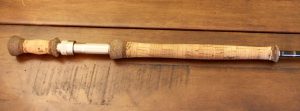
Let’s just get it off our chests. Most casters are terrible in the wind.
Mostly because they do not have to be that sharp. Most fly fishermen are what we can call trouters. I was one myself. The long casts are not really necessary so why bother. Hence fly fishermen trying the salt for the first time will have a very hard time in the wind and cannot get the line out more than say 50 feet. People generally do not practice (for a variety of reasons) which certainly would cure many casting ills.
Captain Baz (http://www.gulfbreezeguideservice.com) has a client that is small and thin and he was fitted out with a stiff brute of a rod that he could not load/bend and it proved to be very hard for us to load/bend it. Naturally, the casts were poor and shortish. It got me looking for alternate solutions. I got a 10’4” rod 6 weight Switch rod (still short enough to land a fish from a boat). I played with it and could get some nice casts overhead with an overhead #8 weight shooting head type line (a brick on a string really). With this setup, very long casts are a breeze. Two-handed rods are rated for Spey lines that are much heavier than the corresponding number for overhead lines thus one needs to go 2-3 numbers higher with an overhead line on a switch rod.
I use a horizontal backcast then up and over vertically (oval cast, Gebertsroither´s cast, Belgian cast) in a continuous motion. Baz’s client tried it and lo and behold he was double handing it with casts 60-80′ no problem. Several other and some rank beginners have tried, and my conclusion is that I can teach just about anyone to cast over 60′ with this technique in one hour. Let’s face it most casters will not practice getting their casts one-handed up to the 100′ wall. Short casts and saltwater are mutually exclusive – with this setup, the odds are much better and fly fishermen can start to enjoy saltwater fly fishing and catch fish instead of the imaginary saltwater fly fishing.
Second scenario.
Bad dominant shoulder. Lots of folks will get problems from arthritic and otherwise damaged shoulders. It is a very common ailment. Lifting of the arm is painful and motion is limited. We get around that by holding the rod with the dominant hand on top of the handle (above the reel). The power is provided by the non-dominant hand holding the rod below the reel. The dominant hand is merely a fulcrum or a pivot point. The movements are much easier on the shoulders this way. It is fairly simple to cast from both shoulders with the shoulder hand on top making it easy to deal with crosswinds.
Naming
These rods are marketed as Switch rods meaning you can cast them with one hand, or you can use a two handed technique i.e. switch from one-handed to two-handed. They are ok to cast one-handed up to 11´ if longer it becomes difficult. The optimal length is from 9-11´. If you plan to use one from a boat, go short. It will be easier to land the fish. Two-handed rods are often called Spey rods which is really a casting technique. It much clearer to just call them one-handed, or two-handed rods.

Up-locking reel seat and space for lower hand
Here is a link to the Spey line weights and # rating. The same link takes you to the overhead line weights and # ratings.

